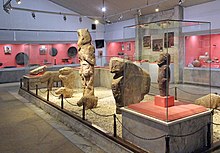Şanlıurfa Archaeology and Mosaic Museums or Şanlıurfa Museum (Turkish: Şanlıurfa Müzesi) are located in the south-eastern city of Şanlıurfa (also known as Urfa), Turkey. The museums contain remains of Şanlıurfa (known as Edessa in antiquity), Göbekli Tepe, Karahan Tepe, Harran (another ancient city which lies 44 kilometres (27 mi) southeast of Şanlıurfa), findings from the Southeastern Anatolia Project and ruins found in the hydroelectric dam reservoirs of Atatürk Dam, Birecik Dam and Karkamış Dam. Both museums are located at Haleplibahçe Mahallesi 2372, Sok Eyyübiye/Şanlıurfa (across the Şanlıurfa Piazza Mall).
Şanlıurfa Arkeoloji ve Mozaik Müzesi | |
 From Göbeklitepe excavations | |
| Established | 2015 |
|---|---|
| Location | Haleplibahçe caddesi, Şanlıurfa, Turkey |
| Coordinates | 37°09′13″N 38°46′54″E / 37.15361°N 38.78167°E |
| Type | Archaeology, Mosaic, Ethnography |
| Collections | Neolithic, Chalcolithic Bronze Age Hittite Assyria, Babylonia |
| Owner | Ministry of Culture and Tourism |

The location history and the building
editThe old museum located at Çamlık Caddesi was opened in 1969 with a display area of 1500sq.m. Later on annexes were added. Before that, archaeological finds were displayed in the rooms of the Şehit-Nüsret-elementary school, therefore in Atatürk-elementary school.
The current museum is on Haleplibahçe street, close to Balıklıgöl, a sacred pool.[1] The museum opened in 2015, and replaced the former museum of Şanlıurfa on Çamlık street. With a closed area of 34,000 square metres (370,000 sq ft), it is one of the biggest museums of in Turkey.[2] The museum consists of two major buildings. To the north is the archaeology museum and to the south is the mosaic museum. In addition to exhibition halls there are offices, a museum lab, a library, restaurants, markets and a playground for kids.
The museum has 3 floors and covers 2,500 square meters of indoor space.
The mosaic museum
editThe mosaic of Orpheus was created in 184 A.D. in Edessa. It was found in 1980, and was taken to United States by illegal means. After some handovers, it returned to Şanlıurfa from the Dallas Museum in 2015.[3]
The archaeology section
editIn the ground and upper floor there are four exhibition halls. The first exhibition hall is reserved for Assyrian, Babylonian and Hittite artifacts. In the second and third halls, Neolithic, Chalcolithic and Bronze Age items such as stone tools, terracota ceramic tools, stamps, pithoi, necklaces, figurines, metallic tools, ornaments, and idols are exhibited.[4] One of the most important items is a 9500-year-old sculpture which is the oldest-known life-size human sculpture.[2] In the ethnographic section, clothes, silver and bronze ornaments, handworks, doors with epitaph, examples of calligraphy, and hand written Korans are exhibited. In the yard, there are various archaeologic items.[4]
It includes the Urfa Man statue, dated c. 9000 BC (11,000 years ago), being considered as the oldest life-sized sculpture of a human already discovered.[5]
Gallery
edit-
Steles and sculptures from Göbekli Tepe
-
Hittite Stele from Gölpinar
-
Stele of Nabonid from Harran
-
Fragment with scribing from Nevalı Çori
-
Basis from Kabahaydar
-
Balikligöl statue
-
Totem
-
Göbeklitepe totem
-
Guard
References
edit- ^ Erman Ertuğrul (25 May 2015). "Urfa'da Haleplibahçe Müze Kompleksi Açıldı". Arkeofili (in Turkish). Retrieved 18 March 2017.
- ^ a b "ŞANLIURFA ARKEOLOJİ MÜZESİ". www.aktuelarkeoloji.com.tr (in Turkish). Retrieved 18 March 2017.
- ^ "Edessa Mozaikleri | Arkeolojihaber". arkeolojihaber.net (in Turkish). Retrieved 18 March 2017.
- ^ a b "Şanlıurfa Arkeoloji ve Mozaik Müzesi - Müze". www.muze.gov.tr (in Turkish). Retrieved 18 March 2017.
- ^ Notroff, Jens; Dietrich, Oliver; Schmidt, Klaus (2015), Renfrew, Colin; Morley, Iain; Boyd, Michael J. (eds.), "Gathering of the Dead? The Early Neolithic Sanctuaries of Göbekli Tepe, Southeastern Turkey", Death Rituals, Social Order and the Archaeology of Immortality in the Ancient World: 'Death Shall Have No Dominion', Cambridge: Cambridge University Press, pp. 65–81, ISBN 978-1-107-08273-1, retrieved 2021-11-13
External links
edit- Media related to Şanlıurfa Archaeological Museum (old) at Wikimedia Commons
- virtual tour
- Turkish Government website
